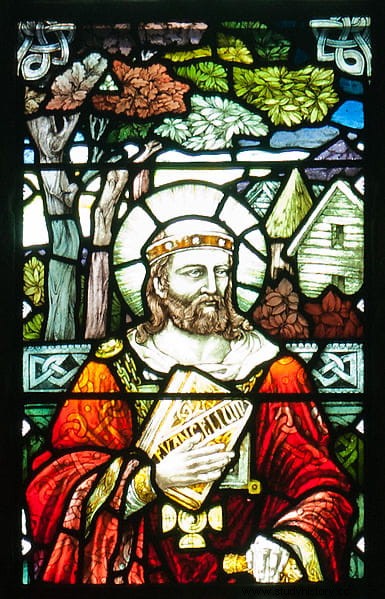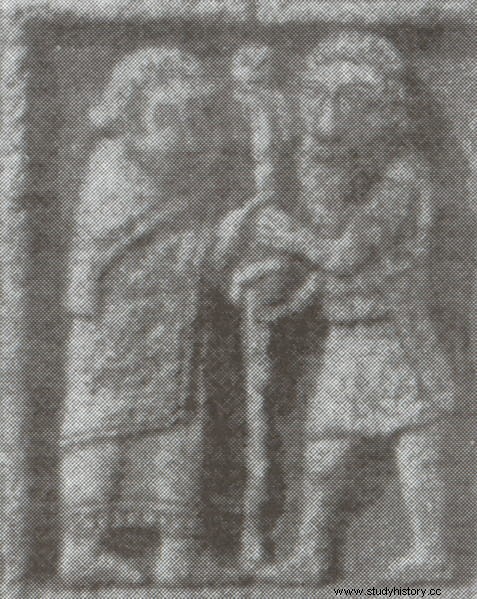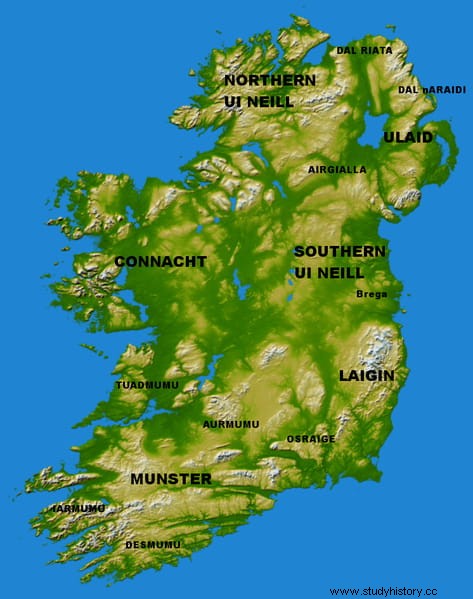Lawsuits for copyright they can be more vehement than they might seem; Here we recently saw a case that also involved the ghost of the famous Mark Twain after having dictated a novel after his death. But it is that they also go back much further in time than is believed and a good example of this is the legend that attributes the origin of the battle of Cúl Dreimhne, in 6th century Ireland, to a copyright dispute. AD It is also known, for that reason, as the Battle of the Book.
It all started in a monastery, a very appropriate place because in that transition from Antiquity to the Middle Ages it was the monasteries that preserved the cultural heritage by copying classics for their libraries. In this particular episode, it was Movilla Abbey, which was located in the town of Newtonards, in County Down, in what is now Northern Ireland. It was one of the most important religious complexes in Ulster, founded in the year 540 by Saint Finnian, an Irish monk also known as Saint Uinniau and whom a recent theory identifies with Saint Ninian of Galloway, the first missionary among the Picts (a translation error in the 8th century would have split him into two different characters).

In any case, Saint Finnian is considered one of the pioneers of the Christianization of Ireland and on an ancient Celtic sanctuary he founded a monastery in which he taught mathematics, geography and history, in addition to using the Vulgate (the translation of the Bible that St. Jerome did in 382 AD) to impart Christian doctrine. In order to spread the faith, he gathered a group of twelve disciples, popularly known as the Apostles of Ireland, of which the most outstanding was a deacon in his twenties named Columba (or Colmcille, in Irish). The chronicles say that he was a descendant of Niall of the Nine Hostages -a pseudo-historical king-, in addition to describing him as tall, stocky and with a powerful voice.
Like the others, he toured the island for a time, preaching and gaining fame as a miracle worker but, above all, completing his training with other illustrious religious, ordering himself a priest. It was a boiling time for Christianity, which was beginning to shake off the druidic tradition that was still in force. But Columba (who would also be canonized) would ironically become the protagonist of the terrible mess that was to come. It was well into the second half of the century when he returned to Moville with the intention of copying the Vulgate to translate it into the Irish language and distribute it to the monasteries. Now, that was also a project that Finnian had, so he would presumably refuse permission. So Columba began to copy behind his back, according to legend in a single night and illuminated by supernatural light.
He had the task almost completed when he was discovered in the scriptorium in full swing, unleashing all the thunder. Finnian demanded the delivery of the copy and he refused. There was no way to reach an agreement and Finnian took the matter to higher levels:the crown no less. At that time he was girded by Diarmait mac Cerbaill, Great King of Tara (Ireland) considered the grandson of the aforementioned Niall of the Nine Hostages and, therefore, a relative of Columba. However, his verdict was in Finnian's favor, expressed very poetically: 'To every cow belongs his calf; to each book a copy of it ». In a way, it was the first ruling on coyright history. . Columba had to deliver the psalter but he did so reluctantly and reluctantly.

Actually, that was not the first disagreement between the two. Long ago, a relative of Columba named Curnán mac Áedo, son of Áed mac Echach (the king of Connacht, present-day province of Connaught), fatally wounded a nobleman during a confrontation. To avoid royal justice, he placed himself under the protection of the Cenel nEógain clan, who in turn left him in the hands of Columba, in the monastery of Kells. But Diarmait's troops stopped him without heeding the fact that being in a termonn (sanctuary) was considered sacred and they killed him right there, which caused the monk's double indignation. Keep in mind that the monarch was pagan, hence his attitude. That happened in the year 559 and now the contrary decision of the king was a new and definitive insult that Columba was not willing to let go.
To such an extent that he, resentful, he had no qualms about organizing a conspiracy against Diarmait. To do this, he contacted the Uí Néill (O'Neil) clans, who claimed to also be grandchildren of Niall of the Nine Hostages and, therefore, have a right to the throne. The Uí Néill divided into several branches, of which two from the north, Cenél Conaill and Cenel nEógain, agreed to collude. The former claimed to be children of Conall Gulban, offspring of the aforementioned Niall and grandfather of Diarmait, as well as king of Tir Chonaill (Tyrconnell, which coincides with the current county of Donegal); the latter claimed descent from his brother Eoghan, ruler of Tir Eógain (present-day County Tyrone).
That the uprising had as its origin something as vain as the copy of a book is a rather late tradition that probably has very little or nothing to do with history - it does not appear in the first documentary references to the battle - and Curnán's death would weigh more heavily. The truth is that both contending parties vied to gain control of Ireland and succeed Diarmait at the head of the Great Kingdom. That is what, in principle, was going to be settled in the year 560 in the battle disputed in Cúl Dreimhne, in Cairbre Drom Cliabh (current county of Sligo), in which a second objective was at stake, since the revolted army, led for Columba himself, he carried the cross while Diarmait's troops clung to the old druidic faith.

The Christian god turned out to be more powerful and the monarch was defeated. However, he was able to retain his throne for five more years, before being assassinated by Áed Dub mac Suibni, king of Dál nAraidi (a part of the Kingdom of Ulaid, Ulster), whom he had banished to prevent him from fulfilling the prophecy that It would kill him, some sources say. According to some historians, he was succeeded by Domnall Ilchegalch y Forguss, of the Cenél nEógain; according to others, the Kingdom of Tara practically disappeared and would not be reborn until the proclamation of Dommall mac Áedo in the year 628. The fact is that the Uí Néill dynasties maintained their power in Ulster until their defeat in 1603, in the War of the Nine Years, after which many of its members went into exile in Christian Europe, an exodus known as the Flight of the Counts.
But that is another story and what is interesting here is to know what happened to Columba, who with his victory in the battle of Cúl Dreimhne had avenged his honor and demonstrated the power of God over paganism. The problem was that his satisfaction left 3,000 dead and, furthermore, since he was a priest, he had taken up arms in violation of divine law. A synod of clerics and scholars was then convened to determine what to do with him. Some of the attendees called for capital punishment while others were content with their excommunication. But as voices were also heard in his defense, including the highly respected theologian Brendan de Birr (another later saint), a compromise solution was agreed that might satisfy everyone. Columba would be banished.
He himself, his conscience affected, accepted the offer as if it were a penance, after consulting with an old hermit named Molaise. The sentence stipulated that he should win for the Christian faith as many souls as deaths had caused his actions. And so Columba, accompanied by twelve monks, embarked on a carragh (typical Irish boat whose hull is made of skins) bound for Scotland. He landed on the island of Iona, which was part of the kingdom of Dál Riata (encompassing the Scottish west coast and the Irish northeast), and there founded an abbey that was to serve as a focus for the evangelization of that land.
By the way, the presumed culprit of everything, the -incomplete- copy that he made of the Vulgate, It is preserved in the Royal Irish Academy in Dublin, where it was transferred from the National Museum of Ireland, under the name of Cathach of Saint Columba . Or so the tradition says, because although paleographically it corresponds to the time, today experts doubt that it is so. It consists of fifty-eight folios (originally one hundred and ten but the rest have been lost) manuscripts on vellum in size 270 x 190 mm. that contain the Psalms in Latin, with each initial letter larger and more decorated. This psalter was used as a Donegal war fetish:before going into battle (that means cathach ), was displayed to the soldiers by monks or holy men who would circle the troop three times with it. Something befitting his background.
